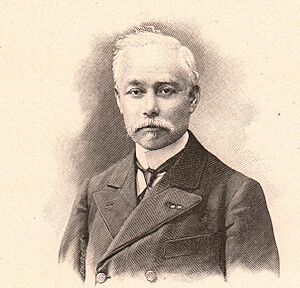Guillaume Bigourdan facts for kids
| 390 Alma | 24 March 1894 |
Quick facts for kids
Camille Guillaume Bigourdan
|
|
|---|---|
 |
|
| Born | 6 April 1851 Sistels
|
| Died | 28 February 1932 (aged 80) |
| Nationality | French |
| Spouse(s) | Marie Mélanie Sophie Mouchez |
| Children | 9 |
| Awards | Lalande Prize (1883, 1891) Valz Prize (1886) Gold Medal of the Royal Astronomical Society Prix Jules Janssen |
| Scientific career | |
| Fields | Astronomy |
| Institutions | Paris Observatory |
| Thesis | Sur l'équation personnelle dans les mesures d'étoiles doubles |
Camille Guillaume Bigourdan (born April 6, 1851 – died February 28, 1932) was a famous French astronomer. He spent many years studying the sky and made important discoveries.
Contents
About His Life
Camille Bigourdan was born in a small town called Sistels in France. His parents were Pierre Bigourdan and Jeanne Carrière. His teachers and the local priest quickly noticed how smart he was.
Because of his intelligence, he was sent to a special boarding school. He did very well there. In 1870, he earned his Baccalauréat, which is like a high school diploma.
Camille married Marie Mélanie Sophie Mouchez. She was the oldest daughter of Admiral Amédée Mouchez. They had nine children together. The whole family often went on vacation to Sistels. They stopped these trips when World War I started. After that, Bigourdan would visit Sistels alone. He would farm his land and see old friends.
He also spoke Occitan, a language used in that part of France. He used it when he was in Sistels.
His Studies and Work
Bigourdan went to the University of Toulouse in 1870. He earned a degree in physics in 1874. Then, he got a degree in mathematics in 1876. To pay for his studies, he worked as a teacher at a boarding school.
Starting His Astronomy Career
In 1877, a scientist named Félix Tisserand hired him. Bigourdan became an assistant astronomer at the Toulouse Observatory. Two years later, in 1879, he moved to the Paris Observatory. This happened when Tisserand became the director there.
In 1886, Bigourdan finished his important doctoral paper. It was about measuring double stars. These are two stars that appear very close together in the sky. His work helped improve how these stars were measured.
Studying Nebulae and Discoveries
Bigourdan spent many years checking the exact positions of 6,380 nebulae. Nebulae are huge clouds of dust and gas in space. He hoped to see if these nebulae moved over time. This movement is called "proper motion."
It turned out that very distant nebulae don't show much proper motion. But during his work, he found about 500 new objects in space! He wrote down all his observations in five large books. These books were over 3,000 pages long.
In 1894, Bigourdan also discovered an asteroid. He named it 390 Alma.
Traveling for Science
Bigourdan loved to travel to see special events in space. In 1882, he went to Martinique to watch the planet Venus pass in front of the Sun. This event is called a "transit." On the same trip, he visited many cities in Europe. These included St. Petersburg, Kraków, Berlin, and Vienna.
In 1892, he traveled to Joal, Senegal. He went there to observe a total solar eclipse. This amazing event happened on April 16, 1893.
Important Roles and Awards
In 1902, Bigourdan helped measure the exact distance between London and Paris. This was done with great care. He became a member of the Bureau des Longitudes in 1903. This group works on time and location measurements. In 1904, he joined the French Academy of Sciences. This is a very respected group of scientists.
Bigourdan was very interested in sending time signals using wireless technology. Because of this, he became the director of the International Time Service in 1913. This service was in charge of setting the new Greenwich time standard. He stayed in this important job until 1928.
He also created a special way to adjust equatorial mount telescopes. This method helps astronomers point their telescopes very accurately. It became known as "Bigourdan's method."
Bigourdan received many awards for his work:
- The Lalande Prize in 1883 and 1891.
- The Valz Prize in 1886.
- The Gold Medal of the Royal Astronomical Society in 1919.
- The Prix Jules Janssen in 1919, which is a top award from the French astronomical society.
From 1919 to 1928, he was also the director of the Bureau International de l'Heure. In 1924, he became the president of the French Academy of Sciences. He had been its vice-president in 1923.
Bigourdan also found many old, lost writings. Some of these were from J.A.G Pingré, another astronomer. He helped with many studies about the history of science. In 1901, he published a book called Annales célestes du XVIIe siècle. This book was about astronomical events in the 17th century.
See also
 In Spanish: Guillaume Bigourdan para niños
In Spanish: Guillaume Bigourdan para niños

